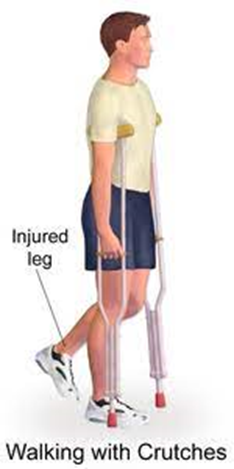A nurse is reinforcing discharge instructions with a client who is walking with crutches. Which of the following statements by the client indicates an understanding of the instructions?
"I should advance my crutches up the step ahead of my unaffected leg."
"I should keep my elbows straight when I am walking with my crutches."
"I will support my weight on the hand grips of the crutches."
"When I'm walking around my house with my crutches, it's okay to take my shoes off."
The Correct Answer is A
Choice A Reason:
"I should advance my crutches up the step ahead of my unaffected leg." This statement demonstrates correct technique for ascending stairs with crutches. When going up stairs, the client should advance the crutches onto the step first, followed by the unaffected leg.
Choice B Reason:
"I should keep my elbows straight when I am walking with my crutches." The client should maintain a slight bend in the elbows while walking with crutches to provide stability and support.
Choice C Reason:
"I will support my weight on the hand grips of the crutches." The client should not support their weight on the hand grips alone; weight should be distributed through the hands and arms to avoid putting excessive pressure on the axillae.
Choice D Reason:
"When I'm walking around my house with my crutches, it's okay to take my shoes off." It is generally not advisable to walk with crutches without shoes, as wearing shoes provides better support and stability. The client should wear supportive, non-skid footwear while using crutches.

Nursing Test Bank
Naxlex Comprehensive Predictor Exams
Related Questions
Correct Answer is A
Explanation
Choice A Reason:
A client can withdraw consent at any time is appropriate. This statement is accurate. Informed consent is a voluntary process, and a client has the right to withdraw their consent at any point before or during a medical procedure.
Choice B Reason:
A family member should witness the client's consent is not a standard practice. Typically, a witness is someone who is neutral and not directly involved in the procedure.
Choice C Reason:
A nurse is responsible for obtaining informed consent is not entirely accurate. While nurses may provide information and answer questions, obtaining informed consent is typically the responsibility of the healthcare provider performing the procedure.
Choice D Reason:
A minor who is pregnant is unable to give consent is not a universally true statement. The ability of a minor to give consent can vary based on legal and ethical considerations, and it may depend on local laws and regulations.
Correct Answer is A
Explanation
Choice A Reason:
"I should advance my crutches up the step ahead of my unaffected leg." This statement demonstrates correct technique for ascending stairs with crutches. When going up stairs, the client should advance the crutches onto the step first, followed by the unaffected leg.
Choice B Reason:
"I should keep my elbows straight when I am walking with my crutches." The client should maintain a slight bend in the elbows while walking with crutches to provide stability and support.
Choice C Reason:
"I will support my weight on the hand grips of the crutches." The client should not support their weight on the hand grips alone; weight should be distributed through the hands and arms to avoid putting excessive pressure on the axillae.
Choice D Reason:
"When I'm walking around my house with my crutches, it's okay to take my shoes off." It is generally not advisable to walk with crutches without shoes, as wearing shoes provides better support and stability. The client should wear supportive, non-skid footwear while using crutches.

Whether you are a student looking to ace your exams or a practicing nurse seeking to enhance your expertise , our nursing education contents will empower you with the confidence and competence to make a difference in the lives of patients and become a respected leader in the healthcare field.
Visit Naxlex, invest in your future and unlock endless possibilities with our unparalleled nursing education contents today
Report Wrong Answer on the Current Question
Do you disagree with the answer? If yes, what is your expected answer? Explain.
Kindly be descriptive with the issue you are facing.
